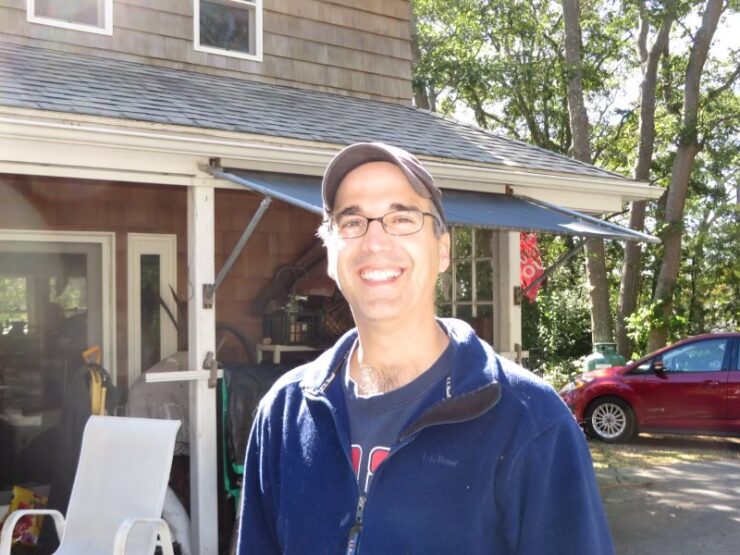By Alexia Partouche
Craig Idlebrook wants to believe that people are smart. When he hears Robert F. Kennedy Jr. talk about vitamins and vaccines, he likes to think that people will know better. However, seeing how people have profited from spreading misinformation fills him with anger and frustration.
But most of all, Idlebrook, 49, is worried for his 10-year-old son.
A writer and editor, Idlebrook speaks to him about world events, and he tries to keep him informed. But Idlebrook sees the deluge of misinformation now becoming mainstream, and he worries about what will happen to his kids and how they see the world.
After all, a little more than a decade ago, he believed those things too.
On August 23, 2024, Kennedy endorsed now-President Donald Trump at a Trump rally with a speech that asked, “Don’t you want a president who is going to make America healthy again?” Since then, the slogan “Make America Healthy Again” has turned into a movement, amplifying misinformation around health topics such as vaccines, just as measles outbreaks have swept across the country.
Health misinformation and conspiracies have been placed in the spotlight — as have the people who believe in them. But although the factors that compel people to believe these things are strong, deprogramming isn’t impossible. They can still be reached.
There are several reasons why people believe misinformation, said Lucy Butler, a research fellow in the Psychology of Misinformation Lab at Northeastern University. Evidence-based science is complicated, while misinformation and conspiracy theories tend to offer simplistic explanations. The naturalistic fallacy — a logical fallacy in which people believe natural things must be healthier — and safety concerns can also provide rabbit holes for well-meaning people to fall into.
What’s more, health as a subject is constantly evolving, meaning that the available treatments tend to be far from perfect, Butler said. This fuels disillusionment in the medical system, which might send people looking for more stable and concrete information.
“People often struggle with a lot of uncertainty surrounding health issues, and misinformation provides a lot more certainty than accurate information does,” Butler said.
Echo chambers
Once people become inclined toward certain false claims, the internet and social media quickly reinforce those beliefs. Especially with the rise of political polarization, people find themselves in echo chambers that don’t question their beliefs, said Alexandros Efstratiou, a postdoctoral scholar at the University of Washington’s Center for an Informed Public.
“When there’s polarization, then there’s essentially a minimization of dialogue between people that would otherwise have different opinions,” Efstratiou said.
Efstratiou said that even when people do venture out to engage with those who disagree with them, the end result is usually those beliefs being fortified rather than challenged.
“Situations in which that happens tend to be quite uncivil, and so that interaction doesn’t necessarily equate to better dialogue,” Efstratiou said. “It just equates to even more backfiring into being even more enclosed into these echo chambers that we talk about.”
The internet has also become ripe ground for disinformation campaigns, which can contribute to and reinforce people’s beliefs in health-related falsehoods.

In 2021, for example, the Wall Street Journal reported that a Russian intelligence campaign had spread false information about COVID-19 vaccines produced by Western countries.
Whether it originates authentically or through an intentional campaign, health misinformation spreads partly because humans are social animals. People trust the people they are close to more than they do public health officials, said Susan Polan, the associate executive director for public affairs and advocacy at the American Public Health Association.
“If I was in your social circle, and I sent out something on social media that was science and evidence-based, you might believe it because you know me, and you could trust me,” Polan said. “And the same thing is true for people who sent out false information but presented as science, because they know you and they trust you and they don’t think you’re going to have anything but their best interest at heart.”
Something to shield against
In the early 2000s, Idlebrook and his wife were living in rural Maine, in an effort to get back to the land. They started out as vegetarians and then switched to veganism. Then their diet consisted only of natural foods. Once they started, Idlebrook said it was hard to stop. Why should they? Idlebrook was feeling healthy, literally climbing mountains in his free time. They were slow to get a telephone and fretted over whether it was acceptable to use a car. Idlebrook renounced toothpaste with fluoride in it and quit going to the dentist. Their group of friends, as concerned with health and the environment as they were, cheered them on.
“The world became something to shield against, rather than something to do better in,” Idlebrook said.
He can’t remember who introduced him to “Mothering,” a natural living parenting magazine, after he and his wife found out they were expecting. Idlebrook studied history and Spanish at Earlham College in Indiana and received a teaching certificate from the University of Findlay. He thought he knew the signs that marked a source as trustworthy, like footnotes describing where information came from. So when he looked at the articles inside, he found what seemed like trustworthy studies on natural food, co-sleeping and the possible dangers of vaccines and the healthcare industry.
When it came time, Idlebrook and his wife tried for a homebirth. As it went on, they rejected the Gatorade bottles offered to his wife to replace electrolytes. After 24 hours, the couple ended up at the hospital, where their daughter arrived only to begin seizing and stop breathing. When all three of them finally left, their daughter was unvaccinated, and Idlebrook and his wife were even more certain about their decision. They just hadn’t been natural enough.
The misinformation firehose
When it comes to health misinformation, the social element is key to both internalizing and unlearning it. When a person’s misinformed beliefs are repeatedly reinforced, it becomes difficult to convince them they are incorrect. They might learn one belief is false, but if they come back to the same environment, they’ll be pulled back in, said John Cook, a senior research fellow at the Melbourne Centre for Behaviour Change.
“If they return to their misinformation firehose of falsehoods, then all that repair can be washed away by continued damage,” Cook said.
Instead, what Cook has found to be successful is giving people the tools to spot misinformation and conspiracy theories for themselves by exposing them to weakened versions of misinformation, otherwise known as “inoculation.”
There are two types of inoculation — preemptive and reactive. Preemptive inoculation teaches people the critical thinking skills to spot misinformation before they actually encounter it, while reactive inoculation helps people unlearn misinformation they already believe.

Cook created a free mobile game called Cranky Uncle, which is intended to inoculate players by teaching them about different misinformation techniques. The game uses cartoons and humor to debunk arguments used to bolster conspiracy theories. For example, the titular Cranky Uncle might ask players to identify the logical fallacy used in a climate denialism argument or to select which claim includes cherry-picked data.
The game has been successful on a small scale, Cook said, but scaling it up has been difficult. He worked with teachers to introduce the game into classrooms, but the use isn’t broad enough yet to shift the needle. Even better than an individual game like Cranky Uncle would be a group activity, where players could play as teams or compete against each other in critical thinking contests.
“Once you socialize, then it spreads,” Cook said.
The same legitimacy as the government
But deprogramming has become more difficult in this political moment, when politicians and other authority figures repeat provably false medical misinformation.
Kennedy, who originated the “Make America Healthy Again” slogan, is now the Secretary of Health and Human Services under Trump. He has previously promoted medical myths that vaccines cause autism and that wireless networks cause cancer. Since assuming the position, he has falsely claimed in an interview with Fox News that the MMR vaccine is ineffective and can cause death. His skepticism has been echoed by Trump, who on Feb. 15 issued an executive order creating a “Make America Healthy Again” Commission, which listed “medical treatments” as a possible cause of childhood chronic illness.
Misinformation that comes from a traditionally legitimate source, such as the government, is harder to combat, said Morgan Wack, a postdoctoral scholar studying misinformation and disinformation at the University of Zurich. Not only are people more likely to trust information coming from these institutions, but it is also more difficult to convincingly fact-check those claims.
“It’s hard to come up with counter-evidence that can be on the same level of legitimacy as from the government, right?” Wack said.
Wack said focusing on weighing and evaluating evidence was one way to help people deal with unreliable institutions.
“I think when it comes to people who are actually in power and promoting things, we can’t get anyone to stop saying things that are untrue, but we can promote quality evidence,” Wack said.
And although messages from government officials are impactful, Cook, the researcher at the Melbourne Centre for Behaviour Change, said the input of friends and family can also make a difference.
“There’s a lot of power in sending social signals, not just from our political leaders or our tribal leaders, but from our peers,” Cook said. “So even just sending views to your family members about respecting science or respecting the facts — that can matter.”
Changing the mind of someone who deeply believes misinformation can be difficult, and breaking through can be almost impossible. However, Cook said that if someone wants to reach out, they should start by approaching the situation with empathy and patience.
“People who tend to be conspiracy theorists, they think of themselves as critical thinkers,” Cook said. “So appealing to the common value of critical thinking and encouraging them gently, with empathy and love, to turn their critical thinking towards their own conspiracy theories can be one approach that might work, but again, it’s a challenging situation.”
Individual moments
Idlebrook’s beliefs didn’t change all at once. He and his wife moved to Boston in 2010, leaving behind rural Maine and their insular group of friends. Once there, some things became clear to him. Surrounded by people who didn’t subscribe to his lifestyle, he noticed how poorly his daughter was dressed and how her rarely combed hair looked. When they registered her for kindergarten, he and his wife lied and said she had a religious exemption from getting vaccinated.
But Idlebrook said he felt an uncomfortable tug on his conscience as they did it, knowing it wasn’t true. Increasingly, their daughter’s well-being became a point of tension, and he and his wife separated. Two weeks later, he met the woman who would eventually become his second wife.
Her family is Jewish and was eager to feed him and his daughter. In their home, he presented a daunting challenge: maintaining a vegetarian diet, insisting on whole grains and refusing to let them give his daughter any sweets. But they persisted, albeit cautiously. Their approach to Idlebrook’s other beliefs was the same. Gently and without judgment, they asked him if he was sure the information he’d heard was right. Idlebrook can’t remember a specific conversation that changed his mind. What he remembers most, instead, is the warmth they approached him with.
“It’d be great if we could just have one person that could give a speech on the Senate floor that can sort of dispel the myth,” Idlebrook said. “I think it’s going to take individual conversations, individual moments.”















Add comment